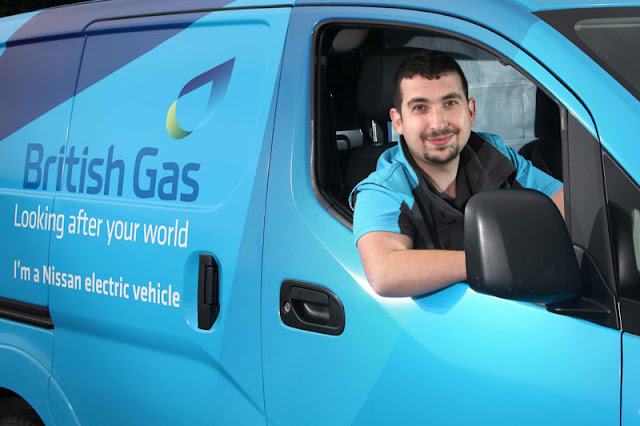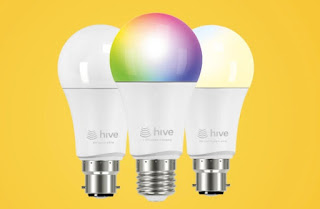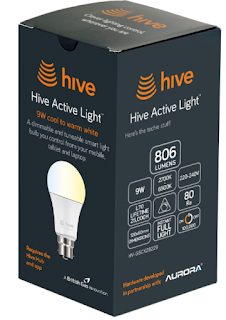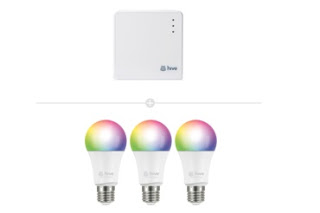TAG | aurora led
British Gas, the UK power utility that is blazing smart home trails with its Hive connected heating system, is now staking a claim to the residential smart lighting market by adding LED lamps to the system, a move that could signal the arrival of other major utilities into the home smart lighting arena.
Through a partnership with LED company Aurora Group, British Gas in June began offering intelligent Hive-branded LED bulbs that tie into the Hive home internet hub, allowing users to wirelessly turn lights on and off and brighten and dim them from anywhere via an app. Last week, it beefed up the offering with bulbs that will change colours and colour temperature.
The LED lamps, supplied by Aurora, are the latest addition to the ever-expanding Hive ecosystem. British Gas – the largest power utility in Britain – launched Hive Active Heating in July 2015 to allow customers to control heating and hot water from computers and gadgets either at home or from around the world. Early this year it added ‘smart plug’ and ‘smart sensor’ products; the plug lets nervous users switch off an outlet if they fear they’ve left the iron on, and the sensors send alerts if they detect motion through a door or window.
Lighting – called Hive Active Light – now fits neatly into the same scheme. Traveling users can, for example, schedule lights to switch on and change brightness as a burglar deterrent. Or they can do the same for their own mood and comfort when they’re at home. A new Hive bulb from Aurora now lets users change colours. Another lets customers tune the colour temperature of white light, in line with the emerging field of ‘circadian lighting’ in which blue-tinged white light can help stimulate people, and red-tinged white light can foster relaxation.
The new products follow on the heels of Hive allowing users to control the Aurora lights with verbal commands using Amazon’s Echo hardware and Alexa software. Hive also works with the ‘if this then that’ tool from service company IFTTT, which lets users program lights to trigger or respond to other things. Clearly, Hive has move beyond its heating roots.
‘Although we started out by launching our smart thermostat, we are more than a central heating business,’ Hive product and commercial director Tom Guy told Lux. ‘For some, the benefits of smart lighting will be about the peace of mind that, while you’re away on business or holiday, you’ve scheduled your lights to come on. For others, it will be about setting the perfect ambience to unwind after a stressful day. For these reasons, smart lighting has the ability to transform people’s experience of the space they live in.’
Guy added that Hive will continue to add functions, and to innovate ways for users to engage with the system. For instance, users can express vocal requests to Amazon’s Alexa in about 80 different phrases germane to the UK , including ‘Alexa, bosh my lights on,’ Guy said.
Internet of Things
It’s all part of the fledging Internet of Things (IoT) in which anything that can be digitised will be for the purposes of improving controls and operations, and of gathering and analysing data.
It is also key to the general beyond illumination movement that is driving the lighting industry in the modern era in which LED lamps are expected to
last for a couple of decades and thus deprive vendors of revenue from replacement sales, long their financial bread-and-butter in the days of traditional incandescent lighting.
Although many LED lighting vendors are touting smart lighting, the concept has been slow to catch on in the home, where it has had something of a limited, upmarket niche appeal. One reason is that in many instances users have to purchase expensive starter kits.
Still, smart home lighting appears poised for a breakthrough. In a recent survey, consulting giant Deloitte said that 40 percent of consumers identified lights as an appliance they would most likely replace with a connected device – tying for the lead with thermostats, which also weighed in at 40 percent. Next came security cameras, at 33 percent, followed by security alarms and fridges, at 30 percent each.
And in its recent annual ‘socket survey,’ Sylvania reported that 76 percent of people agree that ‘smart lighting will eventually replace regular lighting.’
Aurora believes that associating with a utility like British Gas, which has direct access to over 14 million homes in the UK, will help kick-start consumers into deploying Internet-connected lighting.
At your service
The partnership also moves Aurora into the realm of a service industry, which is where many modern lighting companies are trying to position themselves in the face of waning replacement hardware sales.
‘They’ve got 10,000 engineers on the road, so in terms of how they engage with their customers, its’ very, very direct,’ said Neil Salt, managing director of Aurora’s IoT division. ‘We’ve always been excited about what the opportunities would be beyond the bulb and the opportunity came along with Hive. They have real opportunity in terms of their scale and the reach into residential. You can’t ignore they’re a significant player in that space. With men on the ground it makes a significant difference in how the adoption curve will be because you have the face-to-face interaction with people.’
The ‘men on the ground’ aren’t selling Hive Active Light per se. But as service and support engineers who install the smart Hive thermostat, they put a human face to the system, and can help warm up users to the notion of adding smart products such as LED lamps. Customers can purchase the Hive-branded, Aurora-supplied bulbs through the Hive website or from a number of UK retailers including John Lewis, Curry’s, Amazon, Maplin and Screwfix. One original, dimmable bulb costs £19, a set of three costs £49, and five costs £79. The bulbs are rated at 806 lumens, nine watts, 25,000 hours and 2700K. Users control them via Apple or Android devices. Signals travel via ZigBee wireless connections.
The new nine-watt ‘cool-to-warm’ colour temperature bulb is priced at £29, £79 and £119 for one, three or five. The bulbs can range from a warm 2700K to a cool 6500K (in the counterintuitive numbers of the Kelvin scale, higher is cooler). Prices for the 9.5-watt full RGB colour bulb are £44, £119 and £179 for quantities of one, three or five.
Hive makes the bulbs available with either of the UK’s standard socket fitting – ‘screw’ or ‘bayonet.’ The bulbs do not require a Hive Active Heating system, but they do require a hub.
The hub is a small square device that looks like a broadband modem. Hive sells a starter kit including one hub and three bulbs for £89, £119 and £159 for the dimmable white, cool-to-warm, and colour bulbs, respectively.
Existing Hive Active Heating users can tie bulbs into their hubs. New users who want heating, lighting and the other Hive products including smart plugs and sensors can buy kits starting at £299 for a hub and heating, one bulb, an indoor motion sensor and either a door or window sensors; £349 includes an extra lamp plus a smart plug.
Customer retention
Although the Hive deal helps cast Aurora as more of a services company, Aurora’s revenues will come strictly from the conventional modus operandi of selling bulbs. Aurora sells them to Hive, which resells them to customers of its energy services.
The alliance with British Gas should help boost Aurora’s push into smart lighting. The Welwyn Garden City, England-based company is a big champion of IoT lighting. CEO Andrew Johnson is also founder and CEO of St. Petersburg, Florida-based IoT lighting start-up Gooee, which makes technology for companies like Aurora to embed in LED bulbs and luminaires. The Hive bulbs do not use Gooee technology, which is currently more geared to the commercial market, and which is not due out until early 2017
For British Gas, if Hive Active Light helps engage customers, it could help offset a decline in its customer base. The company – which claims to be the world’s oldest power utility with roots going back to 1812 – has about 14.5 million accounts, but it has been losing accounts. In the first quarter of this year alone, 224,000 customers bolted to competitors offering incentives for switching suppliers.
While lighting companies morph more into service entities, the Aurora partnership helps turn British Gas – traditionally a services outfit – into one more reliant on hardware sales. That corollary could help offset the monetary hit that utilities stand to take as people increasingly try to conserve energy and become more energy-efficient.
‘They’re in a bit of a dichotomy at the minute as an industry,’ noted Salt. ‘Everyone wants to buy less of what they’re selling – energy. It’s interesting to see when you look globally at energy and utility companies and how they are looking at creating value beyond energy. The lighting industry has its ‘value beyond illumination’ statement. I think every business as a whole, as things get commoditised, as markets change, it’s interesting to see how they adapt. Energy companies are well-placed. They’ve got their reach, they’ve got their scale, they’ve got customer connectivity. I think it’s great if they’re able to offer products in this ‘smart’ space. It can only be good for all of us to create awareness and serve as a catalyst.’
Of course there are other factors that could help rev up the market. Mass market retailer Ikea, for instance, recently said that it plans to launch an affordable smart lighting line by April.
It’s not clear that Hive Active Light has yet turned into a runaway success. Guy declined to say how many users have gone for it, other than noting that “demand has greatly exceed our expectations.” The broader Hive in general has signed up over 360,000 homes since launching as a heating offering in July 2015, and is the UK’s leading smart thermostat brand, according to Guy.
‘The number of people interested in smart home tech is growing all the time,’ he said. ‘We’re definitely reaching a tipping point.’
It’s still early days. If the market for Hive products and services does indeed heat up in lighting, then watch for more hook-ups between utilities and lighting companies like Aurora.
aurora led · british gas led · hive active light · internet of things · Novel Energy Lighting · smart lighting · wireless lighting
21
How hospital lighting can help patients and save energy
Comments off · Posted by admin in LED
A panel of NHS facilities and energy managers and lighting professionals come together to discuss how lighting in hospitals can be tackled to improve patient outcomes and save energy

- What are the real benefits of investing in new lighting technology for healthcare?
- What are the key mistakes to avoid when upgrading lighting?
- What’s the latest knowledge on how lighting influences patient outcomes?
- How can we make healthier lighting a reality in healthcare facilities?
- How can healthcare bodies get funding for lighting upgrades?
There also needs to be better guidance on what works and what doesn’t and what is considered best practice. This would help me to convince people further up the chain and get funding”Damian Oatway
aurora led · energy efficient lighting · hospital led · hospital lighting · led lighting · Novel Energy Lighting





